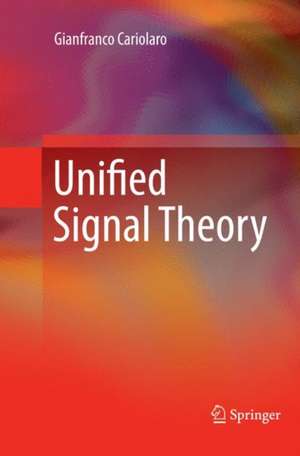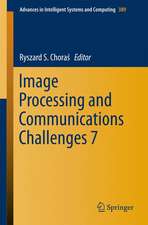Unified Signal Theory
Autor Gianfranco Cariolaroen Limba Engleză Paperback – 4 mai 2017
| Toate formatele și edițiile | Preț | Express |
|---|---|---|
| Paperback (1) | 614.44 lei 38-44 zile | |
| SPRINGER LONDON – 4 mai 2017 | 614.44 lei 38-44 zile | |
| Hardback (1) | 676.86 lei 6-8 săpt. | |
| SPRINGER LONDON – 28 apr 2011 | 676.86 lei 6-8 săpt. |
Preț: 614.44 lei
Preț vechi: 768.05 lei
-20% Nou
Puncte Express: 922
Preț estimativ în valută:
117.57€ • 123.08$ • 97.28£
117.57€ • 123.08$ • 97.28£
Carte tipărită la comandă
Livrare economică 01-07 aprilie
Preluare comenzi: 021 569.72.76
Specificații
ISBN-13: 9781447169208
ISBN-10: 1447169204
Pagini: 928
Ilustrații: XX, 928 p.
Dimensiuni: 155 x 235 mm
Ediția:Softcover reprint of the original 1st ed. 2011
Editura: SPRINGER LONDON
Colecția Springer
Locul publicării:London, United Kingdom
ISBN-10: 1447169204
Pagini: 928
Ilustrații: XX, 928 p.
Dimensiuni: 155 x 235 mm
Ediția:Softcover reprint of the original 1st ed. 2011
Editura: SPRINGER LONDON
Colecția Springer
Locul publicării:London, United Kingdom
Cuprins
Introduction.- Classical Signal Theory.- Unified Theory: Fundamentals.- Unified Theory: Signal-Domain Analysis.- Unified Theory: Frequency Domain Analysis.- Unified Theory: Signal Transformations.- Unified Theory: Multirate Transformations.- Unified Theory: Sampling and Interpolation.- Signals Defined on R.- Signals on R/Z(T).- Signals on Z (T).- Signals on Z (T) / Z (Tp).- Signal Analysis via DSP.- Multidimensional Signals.- Study of Images.- Bibliography.
Recenzii
“Unified signal theory here refers to a development of operations on signals and systems … . The first part of the book is appropriate for an undergraduate level course in Fourier methods in engineering. The middle part containing the unified theory could be used as a hybrid course for mathematics and engineering students, and the last part provides an adequate background to understand techniques and applications in current literature.” (Joseph D. Lakey, Mathematical Reviews, May, 2015)
“The book, which is intended as a textbook for technical and scientific faculties, not necessarily mathematical ones, is at a graduate level, but can be of interest for mathematicians interested in signal theory. … the present volume represents a true treatise in signal theory containing many original ideas. It is surely an excellent scientific work.” (Dumitru Stanomir, Zentralblatt MATH, Vol. 1226, 2012)
“The book, which is intended as a textbook for technical and scientific faculties, not necessarily mathematical ones, is at a graduate level, but can be of interest for mathematicians interested in signal theory. … the present volume represents a true treatise in signal theory containing many original ideas. It is surely an excellent scientific work.” (Dumitru Stanomir, Zentralblatt MATH, Vol. 1226, 2012)
Notă biografică
Gianfranco Cariolaro was born in 1936 and graduated in Electrical Engineering at the University of Padova (Italy) in 1960. He received the Libera Docenza in Electrical Communications in 1968 and was appointed full professor in 1975. Presently he is professor of Optical and Quantum Communications at the University of Padova. His main research interests are in the fields of data transmission, image, digital television, cellular radios, deep space communications, optical and quantum communication. He is the author of several books and has had cooperation with several industries, including Telettra (now Alcatel), Italtel, RAI, ST Microelectronics, Philips, Jet Propulsion Laboratory of NASA, and Eutelsat.
Textul de pe ultima copertă
Unified Signal Theory is an indispensible textbook dealing with the theory of deterministic signals; a topic of fundamental interest to graduates and senior undergraduates in the areas of information engineering (telecommunications, control, systems theory and electronics), astronomy, oceanography, earth science, biology and medicine.
The unified theory follows an innovative approach – that of combining all signal classes into just one. The fundamental signal operations (convolution, Fourier transform, linear systems, sampling and interpolation) are established simultaneously for all the signal classes. This unified approach avoids the repetition of similar concepts consequent on other approaches’ separate treatment of definitions and properties for each signal class. Modern wavelet ideas are developed in harmony with the rest of the text.
Unified Signal Theory provides:
· exercises and examples, to give the student practice;
· solutions which are available for download and save the tutor time; and
· a choice of two suggested reading paths depending on the level of the student, for an enhanced learning experience.
The advantages of the unified approach are many: it permits a global vision of the topic, it is economical in teaching and learning, and it can be adjusted easily to fit new applications. This textbook presents the theory in five chapters, and goes on to demonstrate specific applications such
as fast Fourier transform implementation, sampling and reconstructions of signals, multicarrier modulation systems, image scanning and tomography, in a further six chapters. Mathematical concepts are introduced conceptually within the body of the book with more rigorous treatment being reserved for the appendices.
The unified theory follows an innovative approach – that of combining all signal classes into just one. The fundamental signal operations (convolution, Fourier transform, linear systems, sampling and interpolation) are established simultaneously for all the signal classes. This unified approach avoids the repetition of similar concepts consequent on other approaches’ separate treatment of definitions and properties for each signal class. Modern wavelet ideas are developed in harmony with the rest of the text.
Unified Signal Theory provides:
· exercises and examples, to give the student practice;
· solutions which are available for download and save the tutor time; and
· a choice of two suggested reading paths depending on the level of the student, for an enhanced learning experience.
The advantages of the unified approach are many: it permits a global vision of the topic, it is economical in teaching and learning, and it can be adjusted easily to fit new applications. This textbook presents the theory in five chapters, and goes on to demonstrate specific applications such
as fast Fourier transform implementation, sampling and reconstructions of signals, multicarrier modulation systems, image scanning and tomography, in a further six chapters. Mathematical concepts are introduced conceptually within the body of the book with more rigorous treatment being reserved for the appendices.
Caracteristici
Unified approach to many classes of signal streamlines the process of learning and reduces the volume of repetitious material to be absorbed End-of-chapter exercises and illustrative examples in the text allow students to study privately and test their learning progressively Downloadable pdf solutions manual saves the teacher time Clear section labelling allows tutors to tailor material to advanced undergraduate or graduate levels of study Includes supplementary material: sn.pub/extras





















